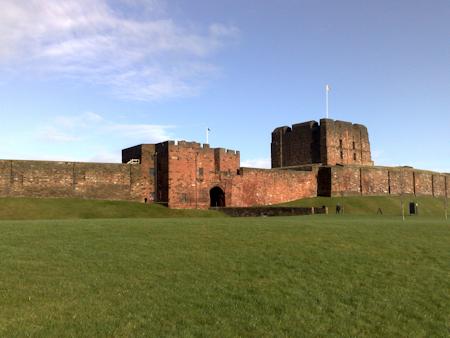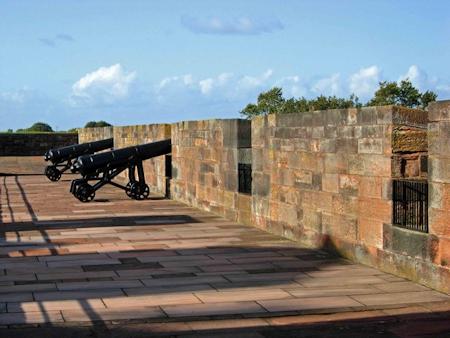
Carlisle Castle
Carlisle Castle sits on a high bluff overlooking the River Eden. The first castle on this site was a wooden motte-and-bailey constructed by William Rufus, son of William the Conqueror, in 1092. He had just invaded Cumbria and driven out the Scots and he needed to secure his territory.
Situated on the border between Scotland and England, Carlisle Castle's location ensured that it would play an important role in British history. It has changed hands frequently and been the backdrop for a number of conflicts.
Attack and Counter-Attack
Henry I commanded that Carlisle should be protected by walls and a stone castle and so the city walls were erected and the massive stone keep was added to the site in 1122. His foresight wasn't rewarded however, as David I of Scotland took the castle in 1136 and the Scots held on to it until Henry II took it back from Malcolm IV in 1157.
Edward I renovated the castle and Carlisle was the seat of his government while he invaded Scotland. After the English defeat at Bannockburn in 1314 Robert the Bruce made his way south and attacked in 1315. Despite his use of siege equipment the castle held with the loss of only 2 English lives.
Around the 1380 the castle was enhanced with three additional watchtowers and the outer gatehouse was rebuilt to include a residential floor.
In the 15th and early 16th Centuries the border region was wild and lawless. Clans and family groups on both sides formed themselves into bands of 'reivers' with the aim of stealing from their neighbours. Their actions weren't sanctioned by either side and both sides aimed to stop it.
The border was divided into three 'Marches' and Carlisle Castle was the seat of the Lord Warden of the West March and the principal seat of royal power in the region. The castle was also used as a prison for reivers and other state prisoners during this time.
Artillery Upgrades
With the renewed threat of hostilities with Scotland in the mid-16th Century, Henry VII ordered a complete review of the castle defences. He brought in Stephan von Haschenperg to re-engineer the castle.
These were the most substantial works since the castle was built. All the alterations were directed at improving the castle defences against artillery. The keep was strengthened and lowered and an artillery platform was added to its roof. The half-moon battery was installed over the inner bailey and bastions were added to cover the outer moat.
Mary, Queen of Scots, was brought to Carlisle castle in 1567. She was housed in the Warden's Tower (later Queen Mary's Tower) and allowed to walk on the "Lady's Walk" in front of the castle. From here she was eventually moved to Bolton Castle in Yorkshire.
Carlisle saw military action again during the English Civil War. It was held by the Royalists and was one of very few sites in the north to hold out for the king. It was eventually taken in 1645 by a combined force of Parliamentarians and Scots.
The castle was also involved in clashes during the second Jacobite uprising a century later in 1745. 'Bonnie' Prince Charlie marched his army south and took Carlisle before marching as far south as Derby. They left a garrison in Carlisle before they retreated over the border and it was taken back by the Duke of Cumberland.
After this Carlisle Castle became an army barracks. The army occupied the castle well into the 20th Century and they destroyed or altered many of castle's important historical features.
Today the castle is owned and run by English Heritage. There are still some military functions here with some of the buildings still in use by the Territorial Army.
The castle is a key tourist attraction in Cumbria and offers a programme of guided tours, a range of events throughout the year and a number of exhibitions on the castle's history. English Heritage also has a range of facilities on site including a gift shop, picnic area and toilets.
Status: Museum / Visitor Attraction
Owner: English Heritage
Tel: +44 (0)1228 591 922
Website: www.english-heritage.org.uk
Opening Times: April - September daily 9.30am to 5pm / October daily 10am - 4pm / November - March weekends only 10am - 4pm


The great keep and gatehouse at Carlisle Castle

Napoleonic guns on the castle's wall walk